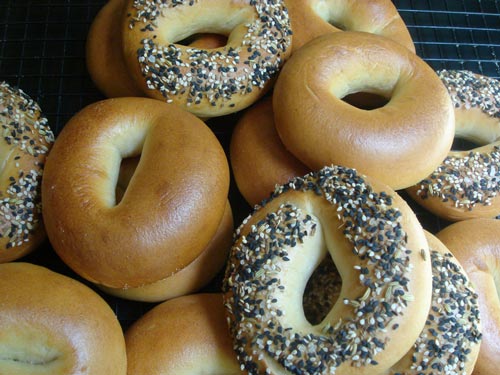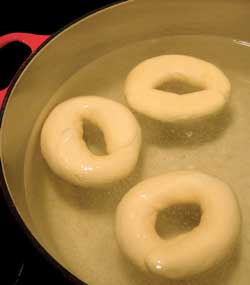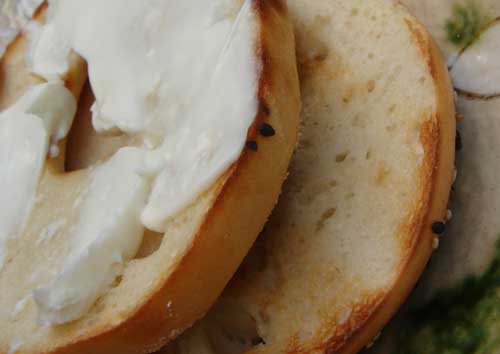I am a morning person. If I’m still in bed at 6:30, even on a weekend, I’ve slept in. I love the stillness before the other creatures in my household are stirring, and sometimes I just spend it over the crossword puzzle and a cup of coffee. But if I’ve started bagels the night before, I have some work to do. Just a little, though: boil and bake, and I’ve got these wonderfully chewy gems in time to take to work, or to welcome my family as they trickle out of bed.
My recipe was originally based on that in Nancy Silverton’s Breads from the La Brea Bakery. If you bake with sourdough, you should have this book. If you haven’t baked with sourdough, why not raise a starter and dive in?
The dough is very stiff, so if you’re not sure what your mixer can do, I suggest halving the recipe the first time around. I know some people mix bagels by hand, but I haven’t spent enough time at the gym to get my delts in sufficient shape for that. If you’re a bodybuilder, though, go nuts. Remember that you’ll need to adjust the water temperature upward to compensate for the lower amount of friction you get with hand mixing. And if you use a mixer, be aware that the stiffness of the dough means the mixing friction is higher than for most breads, which is why I use ice water to end up with the dough at the right temperature.
Did I mention that these are really chewy? If you like a less dense bagel, feel free to increase the amount of water.
This recipe contains only white flour. I’ve got it on my list to experiment with making a portion of it rye or whole wheat, and adding other ingredients to the dough (I’m a sucker for Noah’s cracked peppercorn-potato). Even with this plain dough, the flavor can be varied by using a variety of seeds to top the bagels. I like a mixture of two parts each black and white sesame seeds, one part each anise and fennel seeds, and a pinch of coarse salt.
High-gluten flour (about 14% protein) can be ordered from King Arthur Flour, but if you don’t have it, you can substitute 675 g of your regular bread flour plus 18 g of vital wheat gluten, available in most natural food stores.
Non-diastatic malt powder is also available from King Arthur, or substitute a tablespoon of barley malt syrup, sold in natural foods stores and some supermarkets. Malt is the key to that bagel-y flavor that I love.
Cornmeal can be used in place of the semolina for dusting the parchment, but semolina is finer and interferes less with the texture of the bagels. Brush it off the bottom of the bagels before boiling to avoid getting the water too gritty.
Sixteen bagels require two cookie sheets. If you bake them at the same time, you may need to rotate the sheets halfway through to ensure even browning. If you bake them separately, keep the second batch in the fridge and start boiling them when first ones have about 10 minutes of baking time left.
These freeze exceptionally well, pre-sliced and individually wrapped.
Sourdough Bagels
Yield: 16 bagels, 85 grams each
Time:
- Mix: 10 minutes
- Rest: 10 minutes
- Divide/shape: 20 minutes
- Refrigerate: 8 – 12 hours
- Boil: 20 minutes (includes heating the water)
- Bake: 20 minutes
Desired dough temperature: 78F
Ingredients:
- 693 g high-gluten flour
- 304 g ripe 100%-hydration sourdough starter
- 308 g ice water
- 2.5 g (7/8 t.) instant yeast
- 13.5 g (2 1/4 t.) salt
- 18 g (1 T.) sugar
- 15 g (4 1/3 t.) non-diastatic malt powder
- 47 g milk powder
- Seeds for topping (optional)
- Semolina flour for dusting
- 1 T. baking soda for boiling
Method:
- Combine the flour, starter, water, yeast, salt, sugar, malt, and milk powder in the bowl of a stand mixer. Mix on low speed to combine.
- Mix on medium-low speed until the dough is very smooth and strong, almost rubbery, about 7 minutes.
- Turn the dough out onto an unfloured counter and work a few turns by hand. Form the dough into a smooth ball; the surface should feel satiny and tight.
- Cover the dough loosely with plastic wrap or a towel and let it rest for 10 minutes.
- Divide the dough into 16 pieces of about 85 g each. Form each piece into a light ball, cover, and let rest for 10 minutes.
- Meanwhile, line two cookie sheets with parchment paper and dust them with semolina.
- To shape each bagel, roll the dough into a cylinder about 8 – 10 inches long without tapering the ends. Wrap the cylinder around your hand, with the ends overlapping by about two inches in your palm. Roll your palm on the (still unfloured) counter to smash the ends together. (Note: if the dough is a little dry, give it a quick spritz of water with a fine spray bottle before shaping. This helps it roll more easily, and the ends stick to each other.)
- Place the bagels on the prepared cookie sheets, slip into a large food-grade plastic bag or cover with plastic wrap, and refrigerate overnight.
- In the morning, preheat the oven to 450F.
- Bring a large pot of water to a rolling boil. Do not remove the bagels from the refrigerator until you are ready to boil them. Add the baking soda to the water once it is boiling.
- Meanwhile, place a cooling rack on the counter with a dishtowel underneath it, and place the topping seeds, if using any, on a small plate in a shallow layer.
- Drop the bagels, three or four at a time, into the vigorously boiling water for 20 seconds. They may or may not float right away, but they should float by the time the 20 seconds are up. If they float right away so the tops are not submerged initially, flip them over about halfway through the boil.
- Remove the bagels from the water to the cooling rack with a slotted spatula. Let them drain for about 30 seconds before pressing them, top down, into the seeds and replacing them back onto the semolina-dusted, parchment-lined cookie sheet.
- Turn the oven down to 400F once the bagels are in. Bake until golden brown, about 20 minutes.
- Cool on a wire rack.



Bagels!!! I adore bagels!!! I’ve made them with yeast but haven’t yet tried making them with my natural starter. (I confess that I’m waiting for September when it won’t be so insanely hot during the day. I just can’t bear to be putting a big pot of water on to boil for bagel parboiling as well as turning on the oven!)
But never fear, I’ve made a note of this page.
Also, thank you for mentioning Nancy Silverton’s book. I’ve put an order on it at the library to confirm that it’s a book I need (knead??).
Speaking of kneading, I make bagels by hand and don’t remember having difficulty – and I’m not exactly muscle bound. As I recall, the dough is stiffer than most but it wasn’t that stiff… I use strong bread flour too because like you, we prefer bagels that are chewy.
Whenever I find that dough seems a bit stiff for hand-kneading, I use Carol Field’s (“The Italian Baker”) kneading method for stiff dough: lift it up to about shoulder height and drop it on the board. Fold it in half and repeat. It works really well.
I know what you mean about malt. But I’ve had some really good bagels that used maple syrup in the parboiling water and they were easily as good as malted bagels.
-Elizabeth
P.S. Went to look up what 100% hydration was… the link to “raising a starter” in the body of your post is broken. Happily, I found it:
http://www.wildyeastblog.com/2007/07/13/raising-a-starter/
Do you think I’m right in my guess that 100% hydration starter is a soupy one – like the liquid levain I have made using Susan McKenna Grant’s recipe for natural starter?
P.P.S. I really must apologize for my verbosity!!
Elizabeth, thanks for the heads-up on the broken link; fixed now.
100% hydration just means you feed the starter with equal parts flour and water by weight (i.e., the water is 100% of the flour).
Oh, my I do believe you are one serious baker. I’m in love.
MyKitchenInHalfCups, what a nice compliment. Thank you for visiting!
Beautiful shots! I could just grab one off the screen. It will have to really cool down before I make bagels. At the moment I’m in a steam bath putting up corn and making ketchup!
Wow, those bagels are unreal- They look absolutely flawless! If only I had half of your skill…!
Karen, yes, hot weather is not the best for bagel-making, because they rise too much while shaping, before I can get them in the fridge, and then they’re too bread-y for my taste.
Hannah, you’ve got skill in spades! I can’t wait to try some of your beautiful recipes. (Unfortunately, these bagels are not vegan).
I don’t know what to say; Those are seriously good-looking. Probably the best I’ve ever seen!
Graeme, thanks! The nice thing about photographing bagels is you have a lot to choose from to get the very best ones in the shot. But even the ones that don’t look so nice taste good.
Those are some amazing looking bagels. The ones I made were delicious, but pretty ugly. Wait. Is that an oxymoron? Feh.
Thanks for the great recipe!
The bagels I made developed very nicely overnight, the cooking process worked out ok as well, but when I took them out of the water they collapsed and looked like UFO’s after baking.
Do you have some advise for me for my next try?
Thank you very much!
Rosi
Rosi, it sounds like your bagels were overproofed. This happened to me once when I accidentally left the refrigerator door ajar overnight. I forged valiantly ahead with boiling and baking, but the cause was lost.
You should not see an appreciable rise in the bagels after the overnight rest in the refrigerator. Make sure you get them into the refrigerator right away after shaping. Also make sure your dough temperature is not too warm; the dough temperature after mixing should be about 78F. Because the dough is very stiff, the mixing generates a lot of friction, which raises the temperature of the dough. This is why my recipe calls for cold water.
Hope this helps.
This may be the most amazing bread that I’ve ever made. They were so perfect. Thank you for the inspiration and the clear, thorough instructions.
I posted a picture on my blog.
If you are going to use Wild yeast – sourdough, the addition of commercial yeast is odd. I borrowed that bread book from the library and just returned it without trying the recipes.
I do just fine with Sourdough starter only. If you are a home baker than the fun is using Sourdough and seeing what you get.
Sam, I don’t find the use of sourdough and yeast together here odd, but I would be interested in your bagel recipe with no baker’s yeast.
Just stumbled over your blog. Love it! I’ve got my starter on the counter and bagels in the oven. Thanks so much for the inspiration!
I was disappointed to find that your website is called “Wild Yeast” and yet your recipe for sourdough bagels calls for instant yeast. False advertising I’d say.
Thank you for the recipe! We just had the bagels for breakfast, and they were delicious. I substituted whole wheat flour for 100 grams which worked out really well. I love your blog!
Yet another disappointment while looking for a sourdough recipe. Please, when using commercial yeast call it “sourdough flavor” and when making American style breads call it “pastry breads”, otherwise it just creates search engine glut.
They simply look great. I just recently bought a toastmaster bagel toaster and now i have to try nake bagels for myself. Thanks for the recepie
Have been baking sourdough almost entirely based on Nancy’s book for about 7-years now (which is how old my starter is).
Haven’t done nearly half the recipes yet. The Country White is our standard bread and my son eats a bagel most every morning, except when I make sourdough pancakes — fabulous, mostly just starter — and has a dark choc chip sourdough waffle most afternoons.
Took about a year to get the bagels to the standard where my NY-jew wife approved, but now they’re the only real bagel we’ve yet to find anywhere in our adopted homeland of Oz down-under.
Interestingly, my starter has ended up being about 156% hydration, but all the recipes in her book work fine (I remember from her tutorial she said equal flour and water, but I’m tempted to stick with my blissful ignorance, which works! Must be a Southern Hemisphere thing…)
Your Bagels look wonderful and i hope that the taste in there.
Actually, I’m trying a lot of recipe because I’m planning to open a homemade bagel café in the South of France.
The week i’ll make bagel with your recipe.
Thanks
I have been surprised, since circumstance and poor planning has driven me to this, but a 50% rye hydration starter and no packaged yeast still gave a tasty result, with a chewy center and a crisp crust. Not the light yet chewy creations which grace this page, but still a very tasty morsel.
The next attempt will follow the recipe far more closely however. Is the extra yeast necessary to kick start the mixture, (out of curiosity)?
Hi, this recipe looks amazing and i’ve been dying to make my own bagels… as a beginner who doesn’t really want to buy a rare ingredient as i may not use it again, i’m wondering if the “vital wheat gluten” is necessary? thanks!
Daniel, for this fermentation time (i.e., straight into the fridge with no fermentation at room temperature), the yeast is needed. I will post soon about a 100% sourdough-leavened bagel.
Babs, the extra gluten helps give the bagels their chewy texture. I would not make them without it, but if you prefer a more “bread-y” bagel you might like it.
I was looking for a blog like this before,you got really great information here,I am pleased to check it,Keep it up.Thanks
Some time i really get wonder that how people write something so information like the above details, i am really thanks full of you guys for sharing.Thanks Alot
enjoy that web page layout . How was it produced. It is rather nice!
web Site
http://www.heyheytea.comBlack tea $9.99
These bagels are so perfect they look like they were drawn by walt disney. Can I ask, why the milk powder? And if I omit it, would I need to adjust anything else?
Thanks!
I’ve always made them with milk and I think it enriches the flavor. But try leaving it out and see what you think! You’ll probably want to decrease the water a bit (experiment to find out how much).
Susan- this has been my go to recipe since before I had a scale. Thanks! I’ve made these with the milk powder and without (It’s just not something I usually have on hand). The last time I didn’t have milk powder around I subbed out about a quarter cup of the water for milk. I only make bagels about twice a year and the difference is slight enough that with a six month lead I can’t tell the difference.
Hi, Susan!
I’ve seen much about homemade diastatic powder, but nothing about making non-diastatic malt powder. Do you know if it’s possible to make your own?
Thanks!
I LOVE this blog, and thank you so much for sharing this recipe. I made of batch of these today and they were amazing. It was my first time making bagels and I couldn’t have been happier with them!
Made these bagels yesterday and they came out just like in the picture. Making the starter is like taking care of a pet- it demands daily attention, it makes a big mess, you get attached to it and they it is well worth outcome.
I followed the recipe step by step except I did not have milk powder nor malt powder. They still came out fantastic. My only comment is that apparently 80-85 grams of dough ( just like in the recipe), makes mini-bagels. nothing wrong with it, but if you expect full size bagels I suggest making them from 150-160 grams.
There a lot of bagel recipes that use diastatic malt, would love to hear your thoughts on the issue?
These bagels are the best I’ve made, thank you so much. I was wondering about the crumb. The holes are very small and not as open as other bagels I’ve made. Is this due to my starter? I tried proofing for 1 hr before refridgerating, it helped a little but still a very dense crumb. Just wondering if other people experienced this or it was just me.
Thanks!
Could you make these at night and refrigerate until the next afternoon to finish? Since some of us are not morning people and have to wait until after work 🙂
I know you don’t update this website anymore, and I appreciate you leaving the site live. I have learned a lot from this bread blog! I just made these, and they are the best bagels I have ever eaten. They have just enough tang. I do NOT like 100% sourdough bagels; they are way too sour for me. I highly recommend this recipe because it’s, legit, bakery quality.